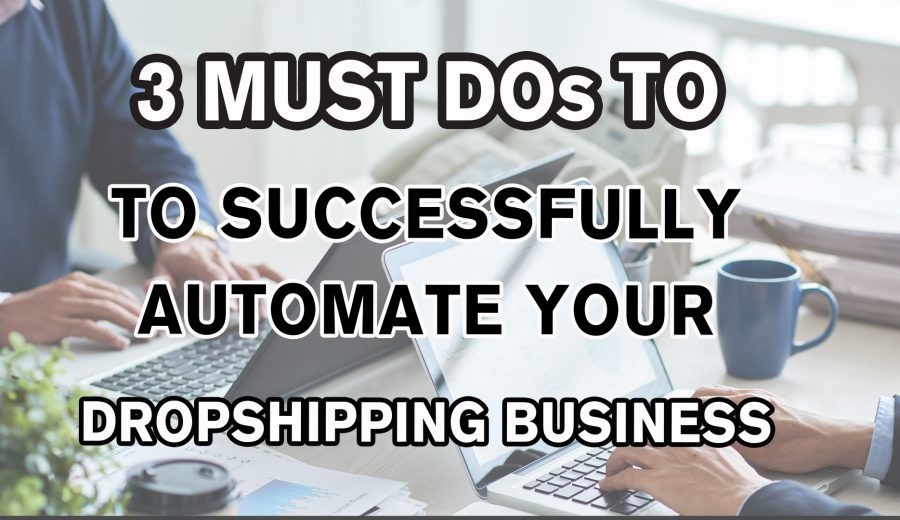The difference between a 7-8 Figure dropshipper and a 5 figure dropshipper.
It comes down to the daily tasks that they do.
5 figure dropshippers try to do everything themselves, from product research, to video editing, to media buying and in some extreme cases, even their customer service.
Whereas a 7-8 figure dropshipper works on finding ways to bring the company to the next level.
- They work on creating a higher customer lifetime value…
- They work on ensuring that the team is at the maximum productivity…
- They work on empowering their team leaders to carry out their vision…
Which is why you don’t see 7-8 figure dropshippers actively doing product research or video editing themselves.
They create systems and delegation systems from product research, to hiring to customer service so that the team can operate without them.
In short, they automate their entire business operations to run without them.
And if that’s what you want to do, then here are 3 must do’s in order to successfully automate dropshipping business.

Crucial mistakes that you may come across.
Oftentimes when dropshippers come to me asking me for advice on creating systems to automate their business, I realize that they make these few crucial mistakes.
- They always feel that their team members cannot do a better job than them, that’s why they are unable to successfully delegate their work out.
- They have no proper training/onboarding process
- They put themselves in every step of the process.
And all of these lead to them being forever “stuck” in their business, doing the same tasks over and over again every single day.
(Don’t you hate that? I sure do)
Pro Tip: A good way to identify if you have successfully automated your dropshipping business, is to take a 2 weeks break from your business. If it doesn’t go into chaos, then you’ve successfully automated your business.
The 3 MUST DO’s To Successfully Automate Your Dropshipping Business
1) Onboarding/Training Your Team And New Hires
A common mistake that most people make is that they think that in order to delegate their work, they just need to hire more people.
WRONG.
It can actually cause the opposite (more work on you) if you don’t have a proper onboarding/training system.
Your new hires end up coming to you asking you questions all the time.
“Is this product ok”
“How should I reply to this customer”
“Is this video Facebook compliant”
Urgh….
But the good news is, we created an onboarding/training system for our clients and now it’s here for you to take it.
Here’s how we do it:
We break down our training into 7 days.
Day 1: Introduction
Most people just go straight into the training or get new hires to work immediately.
But what we’ve found is that setting the right context and culture is much more important so that they can fit easily with the rest of the team.
On day 1, we’ll be going through the following:
- Company values
It’s important to have a clear set of values that helps your employees understand what you stand for. Your company values act as a guidance for their work and a sense of security so that they are more likely to make the right decisions that can help them to achieve the company’s vision and goals.
This is often one of the most overlooked aspects of the onboarding system. But the benefit of it is huge, especially once you automate it.
- Company reporting structure
Again often overlooked, the company reporting structure is to let the trainees know who to look for whenever they face an issue, or have a question.
Oftentimes what most business owners do is to get everyone to report to them.
Can you imagine if you have a team of 10? Or 15? Or 20?
How much time you’ll spend solving problems for them….
By having a clear reporting structure and letting them know to go to a team leader whenever they have questions, it saves you, the business owner, a bulk of time and not to mention head space to focus on higher-level tasks.
Tip: The majority of them will be asking the same old question over and over again, so just get them to report to a team leader instead of you.
- Daily Huddles
If you ever find yourself asking whether your team is working on the right thing, or being productive at their work, then you find this extremely valuable.
In our agency, we like to implement something called a ‘Daily Huddle’ or ‘Stand Up’ in our client’s team.
For those who don’t know, a daily huddle is a short 15 minutes meeting where we have team members sharing what are the 3 tasks that they have to complete today, what are the potential challenges that they face when completing the tasks, and if they need any help from anyone else.
Why do this?
This is so that the team leaders, or you (the business owner), is able to check up on what everyone is doing, and most importantly making sure that their priorities are correct.
From our experience, clients with teams who are not implementing daily huddles are constantly finding their team members working on tasks that are not urgent…
Causing them to panic and firefight whenever an urgent task is due.
- Access to SOPs
On day 1 of the 7D Training System, we also give access to all SOPs, and excel/google sheets to the trainees (only those that are related to their roles).
For example, if the trainee is a product researcher…
We provide him access to the product research SOP, product research criteria, and product research google sheet/excel sheet.
The purpose of this is for them to familiarize themselves with the role, before even starting to work on it.
Pro tip: We help our clients to automate this by putting all the resources and SOPS as part of the onboarding system where they can refer to easily.

Day 2: Onboarding
On day 2, we onboard the trainees by going through their roles and responsibilities with them, and a tutorial on communication tools.
- Roles And Responsibilities
One of the most important parts of the 7D Training System is going through their roles and responsibilities.
Specifically, state the importance of the task.
Most people think that by stating the roles and responsibilities to a team member, it just means telling them what’s their role and what they should do.
That’s not enough.
The most important thing you should do is to also state the importance of the task, and how it affects the company.
For example, let the product researcher know that products are the lifeblood when it comes to product research.
This shows them how important it is to get their work done right.
(It’s also kinda like letting them know that they’re important and treasured. Humans like to feel important that way.)
But more importantly, showing how their work affects the bottomline will give them a great sense of purpose, ownership and responsibility.
By applying this in our client’s training program, we found that this also gave the team members a greater reason to stay whenever things get tough.
Usually up to 5X longer than usual.
- Communication & Management Tools
Together with roles and responsibilities, we also teach the trainees how to use our project management tools and communication tools.
This can be as simple as how your team uses Slack or Clickup.
What most business owners do wrong is that they assume that the trainee will be able to figure out the communication tool themselves.
That’s where miscommunications like:
- Not knowing how to update the next team member from another department that their task has been completed, and that they can now work on it causing unnecessary delay in launching products.
- Not knowing the specific channel to use to find someone from another department.
- Not knowing the due dates for specific tasks.
With these may sound like a small thing, it can get very disruptive and leads to a lot of bottlenecks with the rest of the team.
Like a Porsche engine that gets “choke up” once every 30mins. Not a fun driving experience.
So what do we do?
We create SOPs and video tutorials on how to use these tools.
We then show them what should be done if they wish to contact or update a person from another department.
Just this alone would speed up and smoothen their workflow significantly
(At our agency, we usually recommend our clients to use both Slack and ClickUp as they can both be seamlessly integrated together).

Day 3 & 4: Education
On the 3rd and 4th day of the 7D Training System, this is when we start to teach the trainees on how to perform their roles.
And to ensure that the quality of the training is maintained while you don’t waste too much time with each new hire, make sure to automate everything.
For this, we need to prepare the following assets:
- Books, Blogs, Articles, Case studies relating to the specific role.
For example, providing a case study on Amazon and Zapos’s customer service to the customer service trainees.
- Segments of Dropshipping courses related to the specific role.
For example, providing the product research segment of a dropshipping course to the product research trainees.
Now this is important to ensure high quality: Run them through the assets and get them to write a learning report to you
The learning report is one of the best ways for you to see their understanding of the courses and the assets that you’ve provided them.
It’ll also help them to conceptualize whatever they’ve just learned.
If the learning report is not done well or has a lot of gaps, it means that either your training is not good enough, or they are not good hires (or they didn’t put in a lot of effort, which is a huge red flag)
Day 5 & 6: Shadowing
On days 5th and 6th of the 7D framework, we’ll get the trainees to shadow the existing team members in their departments.
Sometimes, there may be too many contexts or scenario-based questions for the automated training to cover.
So getting the trainees to shadow the existing team can help to cover that.
(For example, getting a product research trainee to shadow a product researcher).
The main purpose of this is for the trainee to understand how to solve a certain situation when faced with a problem.
This will train their critical thinking skills and teach them how to become a “problem solver” instead of a “problem presenter” (only telling you about a problem without trying to solve it).
By the end of the 6th day, issue them with a task to note down their findings and learnings into a learning report again.

Day 7: Examination
Lastly, no training is completed until we can be 100% sure that the trainee is now an ‘expert’ of his role.
At our agency, we help our clients to conduct examinations as a way to be sure that the trainee has sufficient knowledge in his role.
In the exam, we test them on the various topics:
- Company values
List down all of the company values.
- Roles and responsibilities
Pick what’s the desired outcome for your role (Options given)
- Communication
Which communication channel to use when communicating with another department. (Options given)
- Education
What are the criteria to look out for when finding a winning product? (Product researcher)
- Scenario based
What should you do when your ad gets disapproved? (Media Buyer)
In our tests, we have a total of 20 questions mixed from the various topics above.
The passing score for this examination is 80%. (16 out of 20).
By having at least 80% for the examination, you can be fully confident that the trainee is ready to take on his role.
Anything below that, they’ve failed the test and will be let go immediately.
You may be wondering why we let them go instead of training them more…
The reason why we let go of the trainees who failed the examination is because this training is designed to filter out people who have way too little experience and understanding of dropshipping to join the team, or that they did not put enough effort when it comes to learning.
Pro Tip: You can use the app “Typeform” or “Google Classroom” to create these examinations.
2) Documenting ALL Processes
Most dropshippers are always focusing on finding winning products, trying to get a higher ROAS, and finding new media buying hacks.
Don’t get me wrong, those are extremely important.
But without documenting how you do it, it’s impossible for someone to come in and take over you.
(Let alone do a better job than you).
A great way to document your process is to create SOPs.
When you hear SOP, most people think that it’s boring and takes a whole lot of their time, and end up not doing it at all.
But there’s actually a way that you can document your processes down to the T, and in half (or less) of your time.
Here’s how we do it:

First, make sure that every single instruction in your SOP is CLEAR and SPECIFIC.
Essentially, write it in a way where a 5th grader would understand.
A trap that dropshippers fall into is creating SOPs using marketing or dropshipping lingo.
For example, using words like CPP, or CPM, or B-roll (for video editors).
Although it may sound simple to you, it may sound like rocket-science to your team member.
Remember, K.I.S.S. (Keep it stupidly simple).
To paint you a picture:
Here’s an example of bad and good SOP instruction.
“Turn ads off when CPP above $25”
See the potential confusion here?
Your team member may be wondering…
“Do I turn the specific ad off? Or the ad set? Or the campaign?”… “What is CPP?”
Because your instructions were not specific enough, your team member is forced to clarify with you.
Now what does a good SOP instruction look like?
“Turn ads on ad level when cost per purchase is anything ABOVE $25. If the cost per purchase is $25 AND BELOW, leave it ON.”
See how specific and clear it is?
There’s little to no room for confusion if you write an SOP like this.
And remember, the less complex your systems are > the easier to understand > the easier to replicate your systems > the quicker you are able to horizontally scale your business.
Step 2: Record your entire process with audio and screen recording… and keep talking!
This step is significantly important.
While some team members are able to understand with written SOPs, others who are less experienced will not be able to.
To prevent them from bombarding you with questions…
Film SOP videos with step by step instructions!
A mistake that dropshippers make when filming SOP videos is that they tend to speed through the video.
By speeding through the video, you are withholding back more information that you think.
Your goal is to give as much information as possible. Not complete the video as quickly as you can.
Comment every single step along the way, and tell them what you are about to do next.
Bad Example: “Go to Adspy, adjust the filter to this, and find 5 products. Next, copy and paste the link to the product research google sheet.”
Good Example: “First, go to Adspy [dot] com, next adjust the filter accordingly.
Change country to USA, then select dates range to 7 days ago, next click here to change to see videos only.
Once you are done, proceed to look for products.
Remember to select the products that fulfil the criteria of X,X,X,X,X.
Once you have selected the products, copy the link of that product’s Facebook Ad and Aliexpress Ad, and then proceed to the product research google sheet, and then paste both links in this column.”
Notice the difference?
Pro Tip: It’s especially important to make sure that your team members are able to see where your mouse is and where you’re clicking when watching the SOP video.
Personally, I like to turn on the “highlight clicks” function when recording an SOP video, so that my clicks will light up in the video.
3) Create Delegation Systems
As mentioned earlier, 7-8 figure dropshippers systems and delegation systems from product research, to hiring to customer service so that the team can operate without them.
But most dropshippers fail to create proper delegation systems.
Why?
Because most of the time, they fall into the 4 delegation traps:
The “No One Can Do A Better Job Than Me” Trap – The business owner who constantly thinks that they’re the best person for the job, and anyone else will just do a crappy job, killing their business.
The “I Got Burnt Before” Trap – Burnt from prior bad experiences. Hired a product researcher to source for quality products but all he found were crappy ones. Ended up having to go a whole week without any new product launches.
The “I Don’t Have Time To Train Them” Trap – Refusing to spend time to train the team members to do a proper job, resulting in lack of confidence in them, having to micro-manage them every single step of the way.
The “I Don’t Want To Lose Control Of My Baby” Trap – The fear of losing control of your dropshipping business that you’ve painstakingly grown from the ground up.
And after working with many 6 & 7 ecom brands and dropshippers, we have successfully created a framework that can help anyone to create kickass delegation systems.











